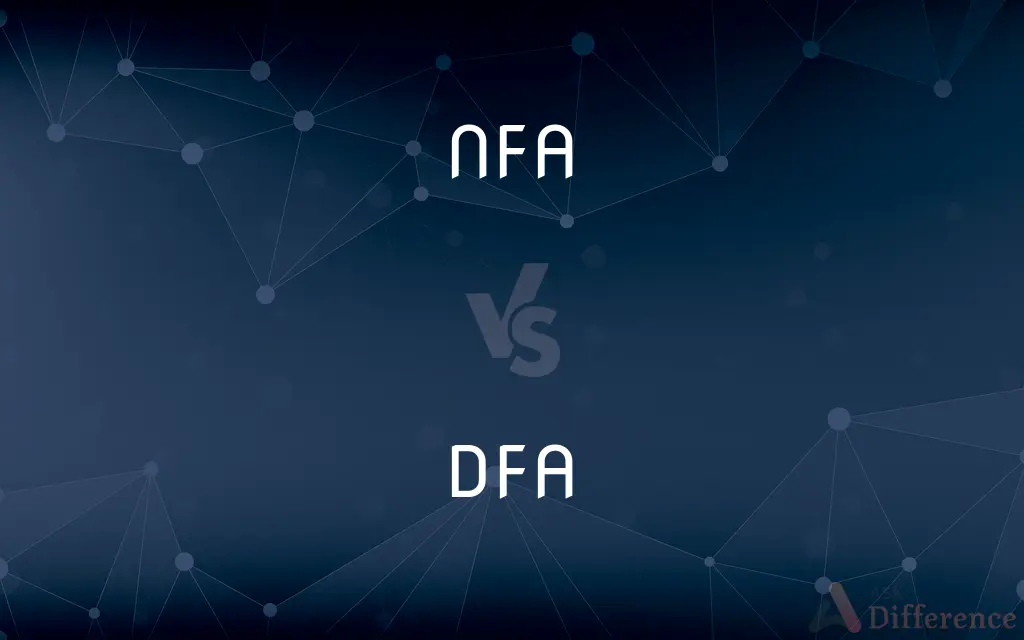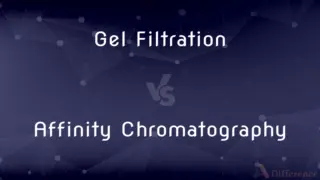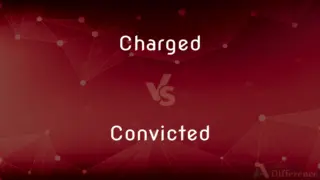NFA vs. DFA — What's the Difference?
Edited by Tayyaba Rehman — By Fiza Rafique — Published on January 10, 2024
NFA (Non-Deterministic Finite Automaton) can have multiple transitions for the same input, whereas DFA (Deterministic Finite Automaton) has exactly one transition for each input.

Difference Between NFA and DFA
Table of Contents
ADVERTISEMENT
Key Differences
The NFA (Non-Deterministic Finite Automaton) allows for multiple or no transitions for a single input from a given state, introducing ambiguity in processing. In contrast, the DFA (Deterministic Finite Automaton) has exactly one transition for each input in a state, ensuring a predictable and unique path.
In NFA, due to its non-deterministic nature, it is possible to have epsilon (empty string) transitions, allowing it to move between states without consuming any input symbols. DFA, on the other hand, does not permit such transitions, mandating the consumption of an input symbol for state transition.
The computational complexity can be higher for NFA, as it may need to explore multiple paths simultaneously; whereas DFA, due to its deterministic nature, follows a single path, often resulting in simpler and faster computation.
In terms of expressiveness, both NFA and DFA are equivalent; any language recognized by an NFA can also be recognized by a DFA. However, converting an NFA to a DFA can lead to an exponential increase in the number of states.
For practical applications, DFA is often preferred for its predictability and ease of implementation. However, NFA can be more convenient in the initial stages of design due to its flexibility and simpler representation of complex patterns.
ADVERTISEMENT
Comparison Chart
Transitions per Input
Can have multiple or zero
Exactly one
Epsilon Transitions
Allowed
Not allowed
Computational Complexity
Potentially higher
Generally lower
Number of States
Generally fewer
Can be exponentially more
Practical Usage
Used in design, theoretical purposes
Preferred in implementation, computation
Compare with Definitions
NFA
NFA is a finite automaton where for some cases, there can be several next states from a given state and symbol.
The regex pattern matching algorithm can be represented using an NFA.
DFA
DFA is used in computer science to represent and control executing systems.
The DFA controlled the software's execution, ensuring predictable outcomes.
NFA
NFA is an abstract machine used in computation and language theory, capable of simulating all languages accepted by Turing machines.
The NFA can be used to model a system with an uncertain state transition.
DFA
DFA is a finite automaton where each state has exactly one transition for each input symbol.
A vending machine can be modeled as a DFA, transitioning states based on coin inputs.
NFA
NFA can transition between states without consuming any input symbols.
In the NFA, a silent transition connects two states without requiring any input.
DFA
DFA is a practical tool for implementing systems that require a predictable and fixed number of states.
The DFA was utilized in the traffic light control system for its predictable state transitions.
NFA
NFA is a conceptual tool for designing and analyzing algorithms.
The NFA provided a flexible framework for the designer to explore multiple algorithmic paths.
DFA
DFA is a deterministic computational model, essential in compiler design and lexical analysis.
The compiler used a DFA to tokenize the source code efficiently.
NFA
NFA is a computational model that performs computations non-deterministically.
An NFA might represent multiple possibilities in a game's decision tree.
DFA
DFA has a unique transition path for each input sequence.
The DFA mapped each user input to a specific response in the interactive system.
Common Curiosities
What is NFA?
NFA is a Non-Deterministic Finite Automaton where multiple transitions for a single input are possible.
Are NFA and DFA equivalent in power?
Yes, both can recognize the same set of languages, but their structures differ.
What is DFA?
DFA is a Deterministic Finite Automaton with exactly one transition per input in each state.
Does DFA allow epsilon transitions?
No, DFA does not permit epsilon transitions; each state transition requires an input.
Can NFA have epsilon transitions?
Yes, NFA can have transitions without consuming any input, known as epsilon transitions.
Why might someone choose NFA over DFA?
NFA offers more flexibility and simplicity in representing complex patterns.
Which is more computationally efficient, NFA or DFA?
DFA is generally more efficient due to its deterministic nature.
Is converting NFA to DFA always possible?
Yes, but the number of states in the resulting DFA can be exponentially larger.
Can DFA have multiple paths for the same input?
No, DFA has a unique path for each input.
Is NFA used in practical applications?
NFA is often used in design and theoretical contexts, while DFA is preferred for practical implementations.
How does the state count compare between NFA and DFA?
NFA typically has fewer states, but converting to DFA can exponentially increase them.
Are NFAs and DFAs applicable outside computer science?
Yes, their concepts are used in various fields like engineering, linguistics, and game theory.
What role do NFAs play in language theory?
NFAs are used to represent and analyze the behavior of languages and computational processes.
Why is DFA preferred in software implementations?
DFA's predictable behavior and computational efficiency make it suitable for software.
Can every DFA be converted to an NFA?
Yes, as DFA is a special case of NFA.
Share Your Discovery

Previous Comparison
Gel Filtration vs. Affinity Chromatography
Next Comparison
Charged vs. ConvictedAuthor Spotlight
Written by
Fiza RafiqueFiza Rafique is a skilled content writer at AskDifference.com, where she meticulously refines and enhances written pieces. Drawing from her vast editorial expertise, Fiza ensures clarity, accuracy, and precision in every article. Passionate about language, she continually seeks to elevate the quality of content for readers worldwide.
Edited by
Tayyaba RehmanTayyaba Rehman is a distinguished writer, currently serving as a primary contributor to askdifference.com. As a researcher in semantics and etymology, Tayyaba's passion for the complexity of languages and their distinctions has found a perfect home on the platform. Tayyaba delves into the intricacies of language, distinguishing between commonly confused words and phrases, thereby providing clarity for readers worldwide.
















































